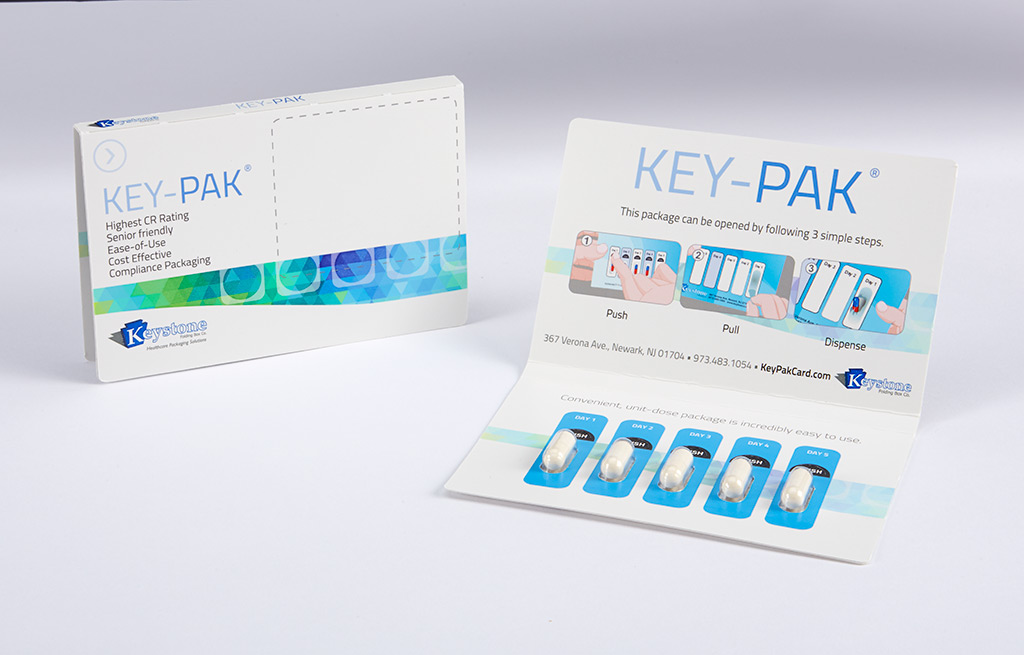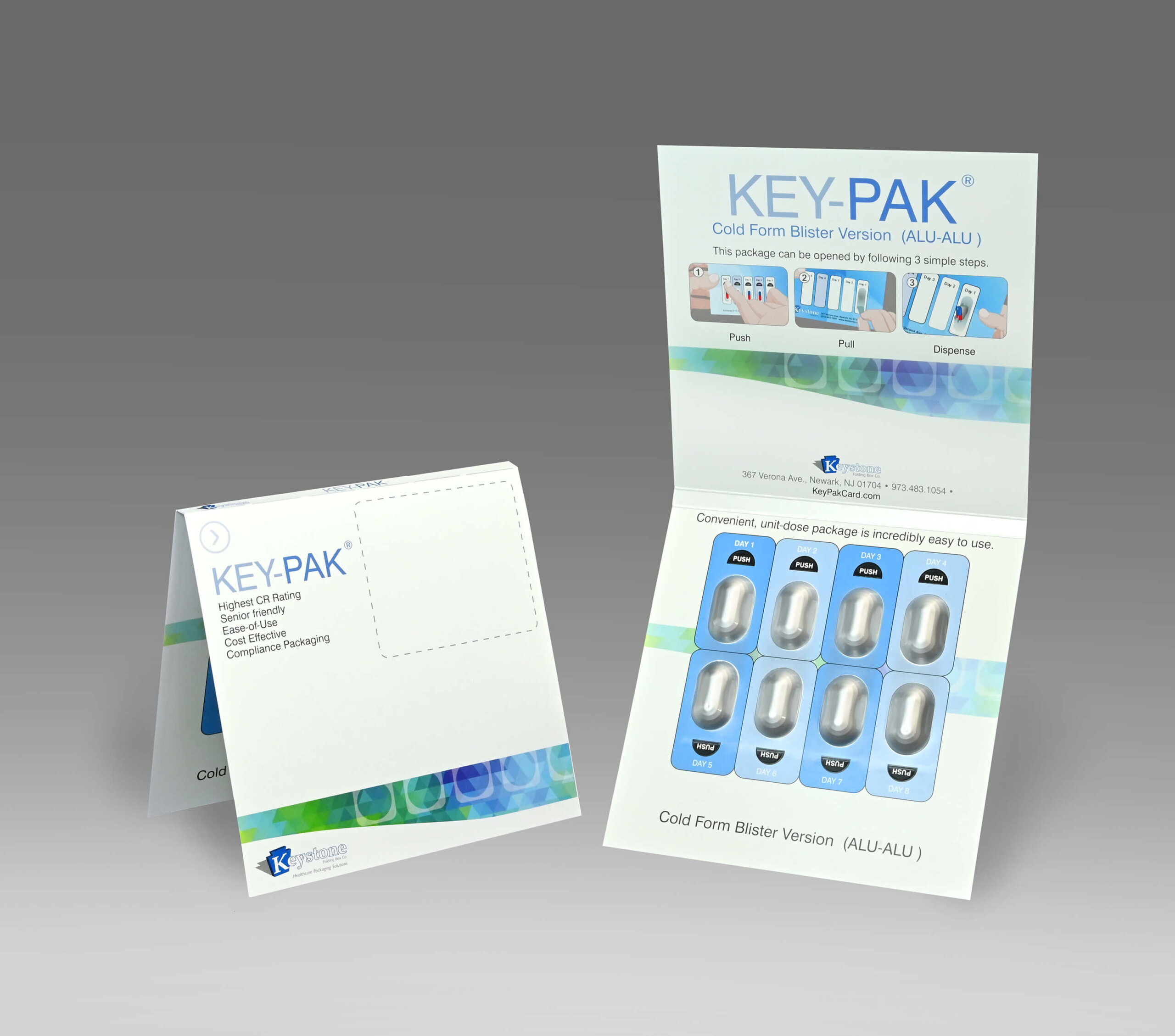Pharmaceutical Blister Packaging
Pharmaceutical Blister Packaging
WHY BLISTER PACKAGING FOR PHARMACEUTICAL PRODUCTS?
While American consumers are accustomed to seeing medications in both bottles and blister packs, bottles remain the dominant format in the U.S. This is in stark contract to much of the remainder of the developed world, including Europe, where 80 percent of medications dispensed are now in blisters.
At Keystone, we see this gap as an opportunity for U.S. pharmaceutical manufacturers – one that allows them to differentiate themselves from the competition through more effective, dynamic and secure packaging solutions. This is because, in evaluating “blister vs. bottles,” blister packaging offers multiple, clear benefits for pharmaceutical manufacturers, pharmacy staff and patients.
It’s a simple question for drug companies: Do you want to improve child safety, product quality and medication adherence or your prescription and over-the-counter pharmaceutical products, all while standing out from competitors? If so, please continue reading about the benefits of blister packs, or contact us to learn more.
BLISTER PACK MEDICATION AND CHILD SAFETY
Studies have consistently shown that blister packaging outperforms child-resistant (CR) bottles. In a 2018 broadcast, CBS News reported on a study citing “Blisters are 65 percent more effective in preventing child access to medications.” The report further states that kids can open child-resistant pill bottles in seconds, risking accidental poisoning. In a test the group set up at a Maryland day care center, children ranging in ages 3 to 5 managed to pop open child-resistant pill bottles in mere seconds.
Child poisoning from access to medications was reported in 8,972 cases in the U.S. The number of accidental poisonings was actually down since the last reported– thanks, in part, to a growing use of blister packages. Part of this is the fallibility of consumers themselves: when caps are inadvertently left partially closed or off, the bottles’ the CR feature become irrelevant, and leaves all pills exposed to a child.
This inherent flaw of bottles can be corrected by CR barriers or other child-resistance mechanisms that can complement blister packaging, such as the push-button slide-lock incorporated into our Ecoslide-RX family of blister pack cartons.
Blister packs can provide a significantly higher level of safety for children. In fact, many blister solutions can provide a child-resistant safety level of F=1, the highest child-resistance rating available.
PATIENT COMPLIANCE & ADHERENCE
Studies have shown a direct connection between calendarized blister packs marked with dates or other information, and improved patient compliance/adherence to dosing regimens.
While medication adherence is a complex issue, calendarized blister packs directly counteract patient forgetfulness by providing a visual dose history for each day of the week.
Improved Adherence: Unit-of-use medications in blister packages are easier to use, particularly for patients taking multiple pills per dose and those who have difficulty remembering proper dosage protocols. By adding printed dosing instructions on the blister pack near each dose, the packaging becomes a “reminder package,” directly impacting insight into dosing history.
Beyond the interaction with physicians and pharmacy staff, the blister package is something the patient interacts with on a daily basis, making it a repetitive communication device with the patient on proper dosing. By comparison, bottles offer no benefit whatsoever in the area of adherence.
More accurate dispensing: Pre-packaged medications in blister packs reduce the chance for dispensing errors within pharmacy operations. Blister pack medication allows prescriptions to be filled faster as no pill counting and repackaging by the pharmacy staff is required, eliminating pill count errors.
If a mistake has been made by a pharmacy staff member when pulling a drug from the shelf, blister packs allow both the name and strength of the drug to remain visible to the patient, allowing the patient an opportunity to verify they have received the correct product. On the other hand, when prescriptions are dispensed in amber vials, the patient has nothing on which to rely other than the pharmacy label and the hope that they have received the correct medication.
Improved refill rates: Blister packages make it easier for patients to manage their own supply of products. With bottles, many patients don’t realize they need to refill their prescription until they are down to the last one or two pills, which can lead to missed doses until the patients can get the prescription refilled. Calendarized blister cards can be printed with “time to refill” near the last five doses in the package, which prompts the patient to call in for a prescription refill.
BLISTER PACK MEDICATION AND PRODUCT QUALITY
Every medication package, both bottle and blister pack, must go through stability testing to ensure an adequate barrier of protection, The goal is to protect the medications from moisture, oxygen or chemical migration—all of which could have a negative impact on the product’s chemical assay and reduce the efficacy of medications.
With a blister package, each individual pill cavity protects the dose inside until you remove a pill from the package. This ensures optimal quality of the product until a patient removes each dose.
Bottles can be deceiving in the area of product quality. When a manufacturer packages product in a 500-count bottle, for example, there is stability data that allows that product to have the necessary barrier protection until the initial opening of the bottle. Once the cap is removed to fill the first prescription and the induction seal is broken, the barrier is never the same. Each time the bottle is opened to fill yet another prescription, the ambient air and humidity of the room is introduced to the remaining product inside. Of course, products sent home with a patient that are packaged in a traditional amber vial also can compound the problem of barrier protection.
WHERE DO WE GO FROM HERE?
While many organizations may feel they are limited to the use of bottles due to their current infrastructure of bottling lines, many contract packaging organizations are well equipped to take on the task of packaging or repackaging medications in blister packs. These contract packagers can adjust for a rapid change in packaging format. Often, the only regulatory requirement is filing a CBE 30 form with the FDA allowing your package to be converted to blisters in a relatively short timeframe. Retailers can purchase drug in bulk from manufacturers or wholesalers, and have contract packagers manage the process of packaging into unit-dose packages. In this case, the only requirement would be compliance with state board of pharmacy guidelines.
With about 80 percent of U.S. pharmaceutical products today being delivered and dispensed in bottles, there is a huge opportunity to utilize more blisters and have a meaningful impact on product quality, child safety and patient outcomes through improved adherence.
If you choose to make the switch to blisters, let us be your blister card partner. Keystone Folding Box Co. is an industry leader in the manufacturer and design of paperboard packaging, including solutions for:
- Pharmaceutical blister packaging
- OTC blister packaging
- Heat-Seal Blister Cards
- Child-Resistant packaging for
- Thermoform blister packaging
- Cold form blister packaging
- Unit dose blister packaging
Because of our extensive background in design and production of secondary packaging for pharmaceutical, OTC, and unit dose blister packaging, Keystone is the market leader in paperboard solutions for pharmaceutical packaging. Our Key-Pak, Ecoslide-RX, and Ecoslide-OTC all allow for use push-through aluminum foil lidding material, which proves to be both cost-effective, patient-friendly and eco-friendly compared to peel-push child-resistant lidding.



